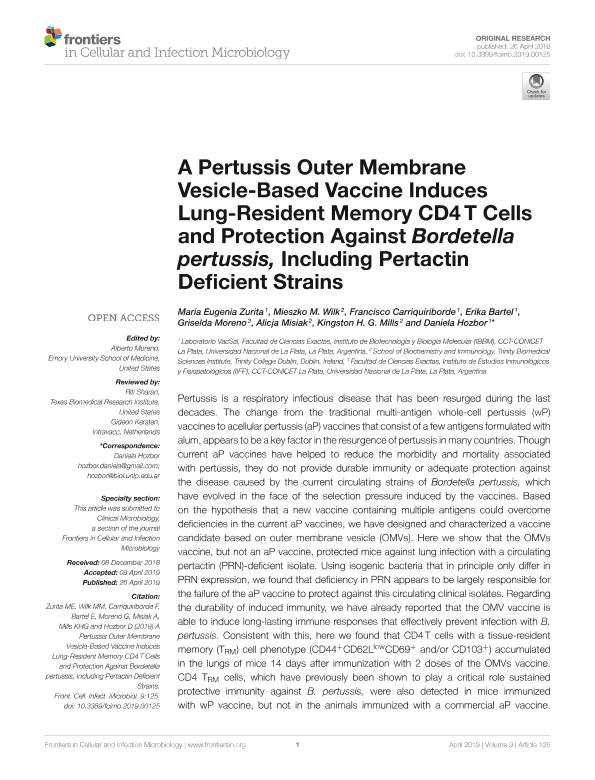Artículo
A pertussis outer membrane vesicle-based vaccine induces lung-resident memory CD4 T cells and protection against bordetella pertussis, including pertactin deficient strains
Zurita, Maria Eugenia ; Wilk, Mieszko M.; Carriquiriborde, Francisco Pablo
; Wilk, Mieszko M.; Carriquiriborde, Francisco Pablo ; Bartel, Erika Belén
; Bartel, Erika Belén ; Moreno, Griselda Noemí
; Moreno, Griselda Noemí ; Misiak, Alicja; Mills, Kingston H. G.; Hozbor, Daniela Flavia
; Misiak, Alicja; Mills, Kingston H. G.; Hozbor, Daniela Flavia
 ; Wilk, Mieszko M.; Carriquiriborde, Francisco Pablo
; Wilk, Mieszko M.; Carriquiriborde, Francisco Pablo ; Bartel, Erika Belén
; Bartel, Erika Belén ; Moreno, Griselda Noemí
; Moreno, Griselda Noemí ; Misiak, Alicja; Mills, Kingston H. G.; Hozbor, Daniela Flavia
; Misiak, Alicja; Mills, Kingston H. G.; Hozbor, Daniela Flavia
Fecha de publicación:
26/04/2019
Editorial:
Frontiers Media
Revista:
Frontiers in Cellular and Infection Microbiology
ISSN:
2235-2988
Idioma:
Inglés
Tipo de recurso:
Artículo publicado
Clasificación temática:
Resumen
Pertussis is a respiratory infectious disease that has been resurged during the last decades. The change from the traditional multi-antigen whole-cell pertussis (wP) vaccines to acellular pertussis (aP) vaccines that consist of a few antigens formulated with alum, appears to be a key factor in the resurgence of pertussis in many countries. Though current aP vaccines have helped to reduce the morbidity and mortality associated with pertussis, they do not provide durable immunity or adequate protection against the disease caused by the current circulating strains of Bordetella pertussis, which have evolved in the face of the selection pressure induced by the vaccines. Based on the hypothesis that a new vaccine containing multiple antigens could overcome deficiencies in the current aP vaccines, we have designed and characterized a vaccine candidate based on outer membrane vesicle (OMVs). Here we show that the OMVs vaccine, but not an aP vaccine, protected mice against lung infection with a circulating pertactin (PRN)-deficient isolate. Using isogenic bacteria that in principle only differ in PRN expression, we found that deficiency in PRN appears to be largely responsible for the failure of the aP vaccine to protect against this circulating clinical isolates. Regarding the durability of induced immunity, we have already reported that the OMV vaccine is able to induce long-lasting immune responses that effectively prevent infection with B. pertussis. Consistent with this, here we found that CD4 T cells with a tissue-resident memory (TRM) cell phenotype (CD44+CD62LlowCD69+ and/or CD103+) accumulated in the lungs of mice 14 days after immunization with 2 doses of the OMVs vaccine. CD4 TRM cells, which have previously been shown to play a critical role sustained protective immunity against B. pertussis, were also detected in mice immunized with wP vaccine, but not in the animals immunized with a commercial aP vaccine. The CD4 TRM cells secreted IFN-γ and IL-17 and were significantly expanded through local proliferation following respiratory challenge of mice with B. pertussis. Our findings that the OMVs vaccine induce respiratory CD4 TRM cells may explain the ability of this vaccine to induce long-term protection and is therefore an ideal candidate for a third generation vaccine against B. pertussis.
Archivos asociados
Licencia
Identificadores
Colecciones
Articulos(IBBM)
Articulos de INST.DE BIOTECNOLOGIA Y BIOLOGIA MOLECULAR
Articulos de INST.DE BIOTECNOLOGIA Y BIOLOGIA MOLECULAR
Articulos(IIFP)
Articulos de INST. DE ESTUDIOS INMUNOLOGICOS Y FISIOPATOLOGICOS
Articulos de INST. DE ESTUDIOS INMUNOLOGICOS Y FISIOPATOLOGICOS
Citación
Zurita, Maria Eugenia; Wilk, Mieszko M.; Carriquiriborde, Francisco Pablo; Bartel, Erika Belén; Moreno, Griselda Noemí; et al.; A pertussis outer membrane vesicle-based vaccine induces lung-resident memory CD4 T cells and protection against bordetella pertussis, including pertactin deficient strains; Frontiers Media; Frontiers in Cellular and Infection Microbiology; 9; 26-4-2019; 1-11
Compartir
Altmétricas



